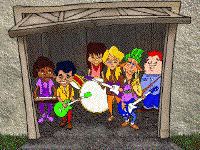





|
Review of
Math for the Real World
 Published by: Knowledge Adventure
Published by: Knowledge Adventure
Year: 1997
Suggested Age Range: 10+
Platform Information: Mac or PC
Reviewer: Brian King and Megan Murray
Image © Knowledge Adventure. Used with permission.
Is the Game Mathematical?
Math for the Real World presents a wide variety of real-life problems you could encounter as you tour the country with your band, such as creating schedules for sharing the driving, figuring out the perimeter of a poster in order to get it framed, or calculating the time it will take you to get from one place to another. Most of these are presented as word or story problems. The game provides a calculator and a handbook you can click on for hints (such as how many ounces are in a cup) or occasionally an actual strategy for solving the problem (such as "take the total number of hours and divide by 24").
The problems vary widely in terms of level of difficulty or complexity, from the fairly simple task of making a phone call by dialing and then depositing the right amount of change in a telephone to the more complicated task of loading all six band members and their gear onto the ferry in groups weighing no more than a specified weight, in the least number of trips possible. In addition, the problems become more complex as you enjoy success with the mathematics, moving from one-step to multi-step problems, or introducing more difficult concepts, such as decimal numbers. Correct answers result in more money in the bank to make your music video. If you answer incorrectly, you get a second chance. Wrong again? This time you lose money from your bank, and you don't learn what it is you did wrong, or how you might have done it right.
Mathematically, the word problems tend to be better than many in currently available games. They mostly do not rely on key words or simple stories. They require careful reading and interpreting to find what the problem is asking, as well as important (or irrelevant) information. The problems challenge kids to apply mathematical concepts to "real life" problems, connecting mathematics to every day experience and expanding kids' views of math. However, many of the problems feel artificial despite the context. You don't visit the hotel you chose, or see your poster framed. You're immediately back on the road, getting hit with another word problem. The math problems allow you to earn money; but they often do not feel like the true play of this game. Because of this, the constant interruptions can end up feeling like a nuisance, distracting you from your journey. On the other hand, feeding the band and filling up with gas seems more consequential: after solving the gas puzzle, your gauge reads full when it read about a quarter of a tank a moment ago, and if you run out of food (or gas), the game is over and you must start again.
Is the Game Equitable?
There are a wide variety of ways players can enter into Math for the Real World. Some children will enjoy the fantasy of joining a rock band and touring the country (research suggests that narrative is a factor that appeals to girls), and the fact that the the band is made up of a racially diverse collection of boys and girls allows many players to imagine themselves in the story. Others will enjoy the musical aspects of both the story and some of the puzzles, as well as the designing of their own music video (research also suggests that design activities are appealing to girls). Some might find the mathematics to be the appeal of this game, while others will enjoy the not-so-mathematical puzzles such as getting the van through a video game-like maze while avoiding screaming fans and photograph-taking journalists (research suggests this type of video game-like activity is more appealing to boys).
In terms of the mathematics, most problems allow for multiple routes to solutions. For example, feeding the band means consulting the menu at Edna's Diner and finding one of many ways to fill each tray with food that totals the specified amount of money. Also, the majority of the mathematics is presented in a way that allows opportunity for shared theorizing and cooperative play, another factor that appears to be important in engaging girls.
Is the Game a Good Game?
Because you are on a 10 city tour and each leg of the tour is quite similar (word problems interspersed with stops for food and gas until you arrive in the city, where play a game and then buy and design a video scene), Math for the Real World does become long and the activities and math problems may not be diverse nor entertaining enough to promote prolonged play. Adding to this sense of tedium is the wait time between activities, where you sit and watch the van on your screen, or listen to your agent make the same speech before the driving puzzle or the designing of a video scene, with no way of jumping ahead to the actual activity.
In addition to the rock-band-touring-the-country theme, the real strength of this game in terms of engagement, is the video design area. This area breaks up the trip, with a stop at the end of each leg (as long as you have enough money), but it is also very engaging. For each scene you get to choose from many different backgrounds, as well as a wide variety of objects and people to place in the foreground. These objects animate when you preview or play your video, and you can use two different options to program their movement: delay allows you to choose when during a scene to play the animations, and loop lets you choose whether the animations will play over and over or only once.
|



